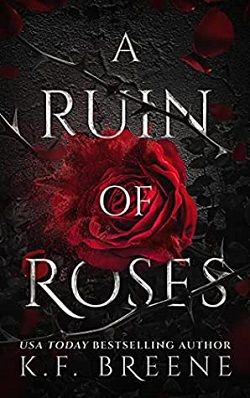It was two minutes before the first of the vehicles came into sight. It was a small, open, slab-sided vehicle—a military version of the Volkswagen, Germany’s answer to the jeep. Four soldiers in the black uniforms of the Waffen-SS rode in the Volkswagen. Behind it was a French Panhard armored car.
Fulmar frowned. The armored car was unexpected. It smelled like the trap he worried about. Behind the Panhard was a Citroën sedan, and behind that a civilian truck, obviously just pressed into service. The truck was large enough to conceal twenty French officers. Or that many Waffen-SS troops. Behind the truck were two other slab-sided Volkswagens holding more Waffen-SS soldiers.
About half a mile from Ksar es Souk, the convoy disappeared from sight in a dip in the terrain. And then it reappeared, rounded a turn, and skidded to a halt. The road had been blocked there by a four-foot-high pile of rocks.
From the tower, Fulmar could see the Berbers waiting for the convoy, but to the Germans the Berbers were invisible.
The Waffen-SS troops jumped from their Volkswagens and formed a defensive perimeter around the convoy.
The Panhard moved in front of the leading Volkswagen and then tried to climb the pile of rocks. Nobody left the truck. Which meant nothing; they might be trying to conceal the presence of more German troops as long as possible.
Fulmar saw the muzzle flashes of the Panhard’s machine gun moments before he heard the sound. And then the Panhard burst into flame, and a huge plume of black gasoline smoke surged into the sky.
There were more muzzle flashes, followed moments later by the rattle of the weapons. Two of the Waffen-SS troopers rushed toward a Berber position before being cut down.
And then the others began to raise their hands in surrender.
One German and three French officers, plus a Waffen-SS driver, came out of the Citroën with their hands in the air. Then the truck disgorged a dozen more Frenchmen—officers, civilians, and, astonishingly, two women. The German officer almost certainly was Obersturmbannführer Müller.
A Berber on horseback appeared. He rode over to the Panhard armored car and took a long, meditative look at two of its crew who had escaped and were lying on the ground. He killed both of them with a burst from his Thompson machine-pistol. He then rode over to the place where the two Waffen-SS troopers had been cut down and fired short bursts into their bodies.
More horsemen appeared. The remaining Germans, including the officer who had been in the Citroën, had their hands tied behind them. A rope was looped around their necks, making a chain of them. And one of the Berbers on horseback started leading them toward Ksar es Souk.
The French officers and the women were left unbound, but they were still unceremoniously herded down the road toward the palace. The vehicles were left where they had stopped.
The operation hadn’t gone exactly as planned, but it had worked, and the armored car hadn’t been nearly as much of a problem as it could have been. And, obviously, Müller was doing what he had been told to do.
Fulmar put the binoculars case around his neck, picked up his Thompson machine-pistol, and wound his way carefully down the narrow stone stairs of the tower.
At the bottom, he emerged into the courtyard. Spotting a small boy, he ordered him in fluent Arabic to fetch the cognac, the coffee service, and the radio from the tower.
Then he started toward the gate from the inner to the outer courtyard. Just before he reached it, he covered his face below the eyes with part of the blue cloth of his headdress. The once-glistening parachutist’s boots were now scarred and torn by the rocks and bushes of the desert; they looked like any old boots. He was quite indistinguishable from a bona fide Berber.
In the outer courtyard there were a hundred Berbers, a third of them women in black robes. The men had painted their faces blue, as was their custom, and most of them were armed as he was with a Thompson. Off at one side, handlers held about forty horses. Fulmar made his way among the men to a group of the leaders and told them what had happened.
And then one of the Berbers touched his shoulder and nodded toward the gate. The horseman with the string of prisoners was now in sight.
“As soon as he’s inside, go get the trucks and cars,” Fulmar ordered. “And see what you can do about hiding the armored car.”
“Why?” the Berber as
ked.
“Just do it,” Fulmar said.
The Berber made a mocking gesture of subservience.
"I hear and obey, O son of heaven,” he said.
“May you catch the French disease and your member turn green and fall off,” Fulmar said.
They laughed at each other, and the Berber walked to where the horses were being held. He swung easily into a tooled leather saddle, then called out the names of half a dozen men, who trotted to the horses and mounted. They rode out of the courtyard as the German prisoners were led inside.
The Germans appeared terrified.
What the hell, Fulmar thought, I’d be terrified too if I was being led with a rope around my neck into a King Arthur and the Knights of the Round Table palace by a bunch of guys with blue faces and submachine guns.
He turned to another Berber.















